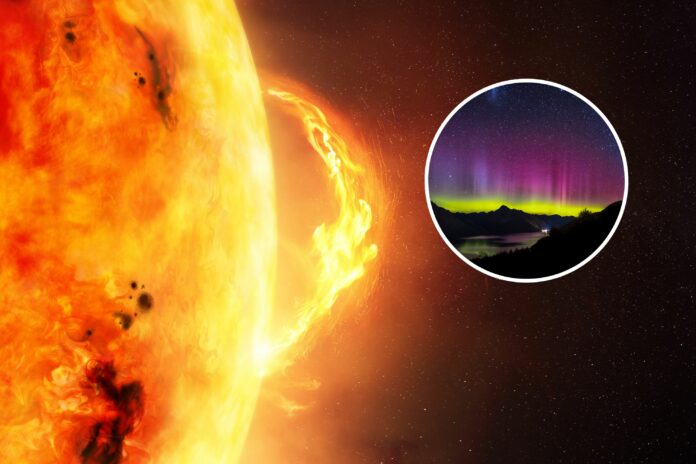The strongest solar storm for years slammed into the Earth’s atmosphere on Sunday, sparking an extremely powerful geomagnetic storm.
The geomagnetic storm triggered by the coronal mass ejection from the sun was classified as a “severe” or G4 storm, and led to auroras lighting up the skies across New Zealand.
This marks the strongest geomagnetic storm seen on Earth since September 2017.
“The 23 March CME arrived at around 24/1411 UTC. Severe (G4) geomagnetic storming has been observed and is expected to continue through the remainder of the 24 March-UTC day and into the first half of 25 March,” NOAA Space Weather posted to X, formerly Twitter, on Sunday evening.
ISTOCK / GETTY IMAGES PLUS
CMEs are enormous clouds of solar plasma that are flung out from the sun during periods of activity, often as a result of realigning magnetic fields at a sunspot. This plasma travels through space at immense speeds of up to 6.7 million miles per hour, which can collide with the Earth. This CME was associated with an X1-class solar flare that erupted from the sun at the same time, on March 22.
“It’s a common misunderstanding that CMEs and solar flares are the same,” Brett Carter, an associate professor in space science at RMIT University in Australia, told Newsweek. “Solar flares are electromagnetic emissions, whereas CMEs are ejections of solar material/mass in the form of plasma (charged particles). They can be very much related to one another (for instance, a solar flare and CME launch can be close-to simultaneous) but they are very different phenomena.”
When CMEs hit the Earth, they interact with the ionosphere, leading to a geomagnetic storm. These are classed on a scale from G1 (minor) to G5 (extreme), making a G4 storm the second-highest level of severity. G4 storms are much rarer than less intense storms, only being seen around 100 times per 11-year solar cycle. G5 storms are only seen about 4 times per cycle, while G1 storms occur around 1,700 times per cycle.
The 23 March CME arrived at around 24/1411 UTC. Severe (G4) geomagnetic storming has been observed and is expected to continue through the remainder of the 24 March-UTC day and into the first half of 25 March. pic.twitter.com/CDXQtyv4yp
— NOAA Space Weather (@NWSSWPC) March 24, 2024
“The intensity of a given storm is related to many things, but one of the most important parameters is the orientation of the magnetic field within the solar wind,” Carter said. “If it’s oriented northwards, Earth’s magnetic field acts as an effective shield, but if it’s southwards the solar wind plasma enters Earth’s magnetosphere much more easily, creating a bigger disturbance.”
More powerful geomagnetic storms can spark more intense auroras in the northern and southern hemispheres. In the U.S., the northern lights may be seen as far south as Alabama or northern California after a G4 storm. As it was daytime in the U.S. and Europe when the coronal mass ejection (CME) hit, auroras weren’t visible, but New Zealand’s night skies were lit up by the aurora australis, or southern lights.
“Under quiet conditions, charged particles (both from the solar wind and the ionosphere) can become trapped in the magnetosphere, happily bouncing from hemisphere-to-hemisphere, pole-to-pole,” Carter said. “Under these circumstances, some of these charged particles will collide with upper atmospheric particles, causing auroras in the polar regions.”
Geomagnetic storms at a G4 level can lead to a number of other impacts to the Earth, including voltage grid issues and radio blackouts, as well as spacecraft experiencing charging and tracking problems.
“The affected infrastructure that is of most importance is large-scale power grids, without which modern society would not be able to function,” Carter said. “Geomagnetically Induced Currents (GICs) are imposed on the power grids, and operators need to contend with them to make sure the equipment does not become overloaded; this is effectively what caused the widespread power outages across Quebec in the infamous 1989 storm. However, research over recent decades has significantly improved the resilience of power grids in key areas.”
The geomagnetic storm is expected to persist into Monday, but be much less powerful.
The geomagnetic storm continues in response to CME passage. G1 (Minor) through G4 (Severe) levels were already reached with this storm. G3 (Strong) or higher storm levels remain possible into the evening as CME progression continues. Please visit https://t.co/9n7phHb5ok for more. pic.twitter.com/yRmniWui6g
— NOAA Space Weather (@NWSSWPC) March 24, 2024
“The geomagnetic storm continues in response to CME passage,” NOAA Space Weather posted to X on Sunday night. “G1 (Minor) through G4 (Severe) levels were already reached with this storm. G3 (Strong) or higher storm levels remain possible into the evening as CME progression continues.”
According to the most recent NOAA advisory, the solar storm remains at a G2 level, and has been weakening. If it persists into the night, auroras may be seen across the northern U.S.
Do you have a tip on a science story that Newsweek should be covering? Do you have a question about CMEs? Let us know via [email protected].
Uncommon Knowledge
Newsweek is committed to challenging conventional wisdom and finding connections in the search for common ground.
Newsweek is committed to challenging conventional wisdom and finding connections in the search for common ground.


